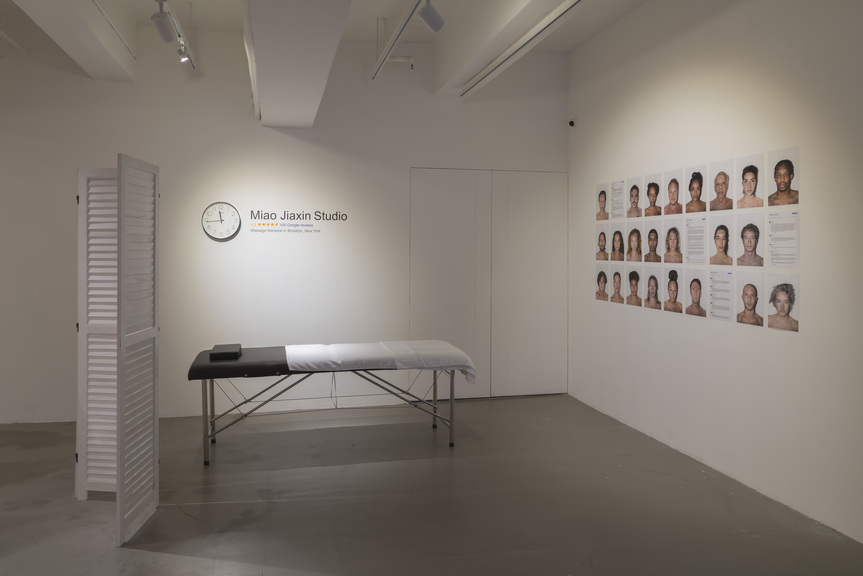-
From Current Issue
-
- Editor’s Letter Fire in the Heart
- Reviews I Gusti Ayu Kadek Murniasih
- Reviews 11th Seoul Mediacity Biennale: “One Escape at a Time”
- Dispatch Networked China
- One on One Monira Al Qadiri on Yukio Mishima
- Essays The rise of independent art spaces in pandemic-era Shanghai
- Features Tuan Andrew Nguyen
- Table of Contents
- Web Exclusives
- Archive
- Subscribe

R
E
V N
E
X
T
Installation view of “Bicycle Thieves” at Para Site, Hong Kong, 2019. All photos by Lily Yi Yi Chan; courtesy Para Site.
The first item many gallery-goers look for upon entering an exhibition is the introductory text. Interestingly, the catalogue of Para Site’s latest group exhibition, “Bicycle Thieves,” is itself an artwork, with an edition of 1,000. Produced by Display Distribute—a conjunction of exhibition venue, pop-up shop, and distribution service run by a research collective—「CATALOGUE」 (2019) contains alternating color-coded sections of curatorial text about the exhibited artists and dispatches from LIGHT LOGISTICS, Display Distribute’s volunteer-operated courier service. Reliant on travellers with excess luggage allowance, LIGHT LOGISTICS is amateur and inefficient, but it primarily serves as an experiment in bringing participants into the day-to-day operations of the art world. This focus on labor and its relationship to art reflected the exhibition’s wider enquiry into how artists negotiate the socioeconomic systems in which they work.
Named after the eponymous 1948 Italian film in which a working-class father is robbed of the transport instrumental to his livelihood, “Bicycle Thieves” explored notions of value, autonomy, and technology’s transformative impact on labor. Hung across the main exhibition space was Chang Yuchen’s One Cooks, the Other Doesn’t (2018), a collection of aprons made of found and hand-dyed fabric. Part of Chang’s brand “Use Value,” the work posits domestic and artistic labor as estranged forms of work: the former yields no income whereas the latter has no useful market rate for reference. Price tags attached to the aprons indicate how much each garment is worth, calculated in part via Chang’s “hourly rate,” an ever-changing average derived from all the wages the artist has earned as a waitress, sales assistant, and graphic designer. By measuring an artist’s value against that of other occupations, Chang questions the relative value of roles in economic production and the market’s arbitrary pricing of art.
In contrast, Miao Jiaxin’s Massage Therapist in Brooklyn (2017–19) foregoes profit as a mode of subversion. By providing free massages to 100 participants in his studio in return for Google reviews and consent to sit for portraits, Miao upsets principles of monetary exchange, which has made participants doubt the service’s legitimacy; as one reviewer notes, the project seems like “a great way to get murdered.” At Para Site, a recreation of Miao’s studio, with a massage table, divider, and clock, was situated in the corner, but the installation is only a proxy of what Miao considers to be the actual work, which exists as a 4.8-star establishment on Google, as the wall print states. (The rating for Miao’s massage parlor has since dropped to 4.7, exemplifying the fluidity of digital evaluation.) By pegging his art to a communal digital platform, Miao circumvents institutions and markets, reconfiguring artistic production as interaction between the artist and collaborators, and art as the sum of these intangible experiences rather than a material product.
It was easy to miss the work calendar and print-out with “NOTICE – HOME DELIVERY” stuck on the door of Para Site’s office. Lantian Xie’s Home-delivery motorcycle parked outside (2019) entails daily lunch deliveries paid for by Xie to Para Site staff. Like Miao, Xie utilizes digital platforms—in this case, delivery apps—to orchestrate live art events, and the fact that the majority of Home-delivery—order taking, food production, transport—is enacted beyond the exhibition space and by people unconnected to Xie’s project simultaneously comments on the invisibility of the labor behind everyday services and their digital interfaces, as well as the forms that art may take as an incidental exercise, with the delivery app functioning like a readymade of sorts.
In response to Hong Kong’s ongoing demonstrations against the proposed extradition bill, exhibition curator Hanlu Zhang dedicated Para Site’s reading room to a display of protest paraphernalia offered by the Hong Kong Artist Union. In the context of citywide strikes and protest actions, in which artists and arts workers have taken part, “Bicycle Thieves” posed timely questions surrounding labor, socioeconomic inequities, and art’s relationship to society. The exhibition foregrounded the control of market forces as well as modes of subversion, positioning artists as inextricable from the infrastructures they criticize yet crucial to undercutting them by providing perspectives from the periphery.
“Bicycle Thieves” is on view at Para Site, Hong Kong, until September 1, 2019.
To read more of ArtAsiaPacific’s articles, visit our Digital Library.



















